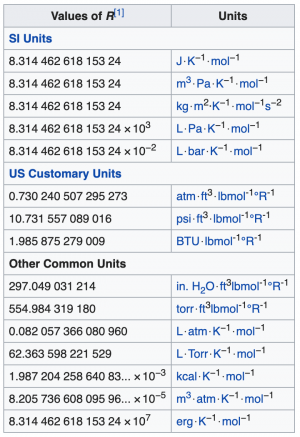Difference between revisions of "Ch5 Lec 3"
Jump to navigation
Jump to search
| Line 26: | Line 26: | ||
====Question 2==== | ====Question 2==== | ||
If given the V, n, and T, which gas constant would you use if you want to calculate the pressure in "bar"? | If given the V, n, and T, which gas constant would you use if you want to calculate the pressure in "bar"? | ||
| − | <div align="right">Answer: 0. | + | <div align="right">Answer: 0.08314 L*bar/(mol*K)</div> |
Given: | Given: | ||
Revision as of 20:12, 30 March 2020
in progress...
Ideal Gas Law Equation (Sec 5.4)
When combining all of the gas laws, Boyles, Charles', and Avogadro's we get the Ideal Gas Law Equation: As with any mathematical relationship/equation, if there are 5 variables (P, V, n, R, T) all you need to know is 4 of them and the 5th can be calculated.
R, the gas constant is equal to (depending on the units):
Question 1
If given the following data, which gas constant would you use?
- P = 1.12 atm
- V= 2.45 L
- n = 1.00 moles
- T = 298 K
Answer: 0.082057 L*atm/(mol*K)
If the volume was not given in the question above, show how it can be calculated:
- P = 1.12 atm
- n = 1.00 moles
- T = 298 K
- R = 0.082057 l*atm/(mol*K)
Calculate V and make sure your work shows how the units cancel:
Question 2
If given the V, n, and T, which gas constant would you use if you want to calculate the pressure in "bar"?
Answer: 0.08314 L*bar/(mol*K)
Given:
- V= 22.4 L
- n = 1.00 moles
- T = 298 K
- R = from above...
Calculate the pressure in bar and make sure your work shows how the units cancel:


